
FOCUS BEN RUSSELL

Ben Russell
Ben Russell (1976) is an American artist, filmmaker and curator whose work lies at the intersection of ethnography and psychedelia. His films and installations are in direct conversation with the history of the documentary image, providing a time-based inquiry into trance phenomena. Russell was an exhibiting artist at documenta 14 (2017) and his work has been presented at the Centre Georges Pompidou, the Museum of Modern Art, the Tate Modern, the Museum of Modern Art Chicago, the Venice Film Festival and the Berlinale, among others. He is a recipient of a Guggenheim Fellowship (2008), a FIPRESCI International Critics Prize (IFFR 2010, Gijón 2017), premiered his second and third feature films at the Locarno Film Festival (2013, 2017) and won the Encounters Grand Prize at the Berlinale Film Festival (2024). Curatorial projects include Magic Lantern (Providence, USA, 2005-2007), BEN RUSSELL (Chicago, USA, 2009-2011), Hallucinations (Athens, Greece, 2017) and Double Vision (Marseille, France 2024-). He is currently based in Marseille, France.

What filmmaker and artist Ben Russell proposes with his films, a selection of which we will be able to see at this edition of the Family Film Project, are critical materializations of various interpretations of the travel experience — both internal and external, physical and metaphorical, real and surreal — just as cinema can convey.
In the short films of the Trypps series, made between 2005 and 2010, we can recognize the entire program of Russell’s cinema, immediately inscribed and reflected in the title, and explored in the form of cinematic miniatures that test and expand the limits of cinematic experience and forms through the intersection of experimentalism, performance, psychedelia, ethnography, and elements of cinema history and its devices.
These films make explicit the director’s interest in exploring movement (rather than narration) as the fundamental element of cinema. They simultaneously hark back to cinema's beginnings, specifically the documentary and ethnographic lineage, which observes the 'objective' movement of the world and its inhabitants, and the experimental lineage, attentive to the formal and affective qualities of the extremes of cinema's own movement. They also connect with more contemporary trends in ethnographic and experimental film, in their sensory and structural aspects, as a way of accessing interior and subjective movement — i.e., the psyche — and, by extension, the intersubjective and intercultural experience of life.
The theme of travel, therefore, emerges as a way to unite ethnography and psychedelia through the poetics of cinematic imagery. This translates into formal investigations that destabilize traditional divisions between documentary and fiction and challenge our viewing habits. Involving the real characters of the films, viewers, and the director, these works aim to trigger collaborative, immersive, and collective experiences of trance, ritual, and transcendence, to produce the equivalent of a speculative treatment of subjectivity. The free movement across the world, from Rhode Island to Suriname, passing through Dubai, the Badlands (Trypps, 2005-2010; Let Each One Go Where It May, 2009; He Who Eats Children, 2016), Malta (Atlantis, 2014), Finland, Greece (The Invisible Mountain, 2021), Marseille (Against Time, 2022), among other places, culminating in Notre Dame des Landes, in the Zone à Défendre (Direct Action, 2024, co-directed with Guillaume Cailleau), with a camera in hand, is a way of encountering other forms of life, many of which are underrepresented, and other psychic states, and through the often shared act of filming and giving them shape, to provoke—or hope to provoke—a transformation in return.
On this subject, Ben Russell, following in the footsteps of Trinh T. Minh-Ha, notes that the documentary, as a category to designate a material, genre, approach, or set of techniques to approach reality and the other, which would oppose fiction, does not exist, as we are always faced with a ‘creative treatment of reality’. This does not correspond to a refutation of the truth or factuality of the image, but rather to the fact that there is always a selection involved in the process of its production and the decision to record or capture.
Form is content; in other words, it is always about creating something that is only possible thanks to cinema and is inherently a cinematic experience—an experience that is also that of the image, not only in a reflective sense but also in a performative and phenomenological sense.
At the same time, to represent or frame does not mean to close off or turn the other into an object of knowledge. Thus, the tradition of ethnographic cinema as an objective form of knowledge of the 'self' through others must be complemented by the ambition, which Russell recognizes in psychedelic thought and practices, of a sensory and subjective understanding of ourselves and the world. "The result is a simultaneously embodied and critical dialectic, in which the terrors and pleasures of losing ourselves are balanced by the need to know where we are, who we are, and what we are, particularly in relation to those who are not us.” (Interview by Luciana Dumitru with Ben Russell, https://bieff.wordpress.com/2013/12/12/river-rites-interview-with-ben-russell/, accessed on August 22, 2024).
Ben Russell’s cinema reinterprets Jean Rouch’s cine-trance approach, focusing on intuitive and emotional understanding rather than traditional ethnographic knowledge. His "psychedelic ethnography" blends subjective experience with critical analysis, aiming for an empathetic understanding of otherness through cinema itself. Russell approaches ethnography as an artist, downplaying its disciplinary and scientific dimensions and emphasizing the experiential and ecstatic aspects of rituals.
He is interested in exploring the semiotics of spirituality and religiosity, as manifested through external signs that vary from culture to culture but reflect the same common and universal need for connection with the transcendent. However, what he seeks is to capture or stage a particular type of experience to translate it into a completely different one. It is through the transition from the ethnographic realm to the cinematic realm that Ben Russell can place the dual ritualistic nature of intercultural trance phenomena under tension, by combining, for example, the trance of Saramaccan culture with the countercultural practices in which he is immersed, as well as the act of filming. This is how, structurally, films like Black and White Trypps Number Three (2007) and Trypps #6 (Malobi) (2009) share, in Russell's own words, not only trance as a common experience but also music as a catalyst for rituals. One trance is secular, triggered by the music of a Lightning Bolt concert, while the other is initiated by the ritual and funeral ceremony of Adjo. They are similar because they show us that the authenticity of what we see is doubly linked to reality—the people, the experiences that shape the film—and its mise-en-scène, made tangible by the presence of clapboards, camera movements, and flash frames, which force us to reposition ourselves not only in relation to the world but also to the image itself.
In turn, films like Let Each One Go Where He May (2009), his first feature film, and He Who Eats Children (2016), or, for example, Atlantis (2014) and The Invisible Mountain (2021), extend the exploration of the same paradox, constructing speculative and hallucinatory portraits, evoking the fictional or mythical idea of a lost civilization or the search for a utopian mountain: what unfolds before the camera is a mixture of facts and staging, of reality and representation.
What becomes relevant is not the truth or authenticity of the experience recorded by the camera, with its function of differentiating one culture from another, but the ritualistic experience of cinema itself, beyond any mediation or translation, in an exercise of subjective or reflexive ethnography.
Cinema emerges as that speculative and reflective non-place about and of subjectivities and their production, returning to us the utopia of other possible ways of life. Through rituals and various kinds of transcendent journeys, beyond the impenetrability of other people's psyches and the signs that hint at them, what stands out is the universality of a common, post-colonial human subjectivity, in the sense of similarity beyond differences, in the way it returns to us an image of ourselves as others, through cinema and how it allows us to engage in a visceral and phenomenological equivalent of the movement of forms and bodies on the screen.
Conditioned by the determinisms of our lives, we sometimes forget that we do not live in the best of all possible worlds and that the world is also constituted by the potential of alternative modes of existence. Russell's camera investigates these alternative, individual, and collective subjectivities, resonating in the present with surrealist, psychedelic, communal, and political utopias through the utopia of cinema itself:
‘This society of humans that still quietly gathers in the dark, that briefly lives a collective life under a unified shimmering vision—and then disperses, each individual transformed, and returns to their own daily life: it is the closest to an ideal society that I can imagine. I am talking about cinema, of course, and I am increasingly convinced that cinema is the only place where utopia can be truly realized. It is a non-place, a time-space, a present that is always arriving and that needs our presence to exist.’ (Interview by Erika Balsom with Ben Russell, about Atlantis, https://www.vdrome.org/ben-russell-atlantis/, accessed on August 22, 2024)
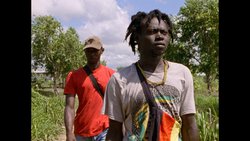
16 OCT | 21H15 | BATALHA CENTRO DE CINEMA | SALA 1 | 135’
Let Each One Go Where He May
2009 | USA | 135’
"Let Each One Go Where He May is the stunning feature debut of celebrated Chicago-based filmmaker Ben Russell. Having its world premiere in Toronto, the film traces the extensive journey of two unidentified brothers who venture from the outskirts of Paramaribo, Suriname, on land and through rapids, past a Maroon village on the Upper Suriname River, tracing the voyage undertaken by their ancestors, who escaped from slavery at the hands of the Dutch 300 years prior. Shot almost entirely with a 16mm Steadicam rig in thirteen extended tracking shots, this cartographic portrayal of contemporary Saramaccan culture is a rigorous and exquisite work that partakes in and dismantles traditional ethnography, inviting anachronism and myth-making to participate in the film’s daring conflation of history." - Andréa Picard, TIFF
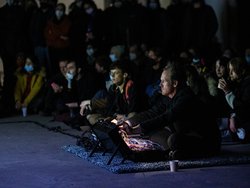
17 OCT | 21H15 | BATALHA CENTRO DE CINEMA - SALA 1 | 25´
PERFORMANCE BY BEN RUSSELL
CONJURING
Analogue synthesis as a tool for conjuring: A mountain emerges, an invisible summit appears. We are earth and the mountain is earth and we climb forever upwards along a chaos of slopes where synaesthesia is feeling, mapping is modeling, volume (sound) is volume (space), and waveform is mountain song.

18 OCT | 14H00 | BATALHA CENTRO DE CINEMA - SALA 1 | 40’
In this conversation, we will take as a starting point the themes of travel and cinematic utopia, which are central to Ben Russell's work, to discuss several of the director's films. We will explore his focus on uniting experimentalism, psychedelia, and ethnography as a way of questioning the sensory and subjective dimensions of cinema, thus expanding the spectrum of possible worlds it allows us to create and experience. - Susana Nascimento Duarte
BIOGRAPHY
Susana Nascimento Duarte is an adjunct professor at ESAD.CR, where she coordinates the master in Arts of Sound and Image, and a researcher at CineLab, Ifilnova.
She has a PhD in Communication Sciences from Universidade Nova de Lisboa.
She has written on the aesthetics and politics of documentary film and on cinema as an archaeological tool for the critique of contemporary culture.
She was one of the programmers of the cycle of meetings What is the Archive?, an initiative of the Arquivo Municipal de Lisboa Videotheque (2017-19).
She is the editor of the Interviews section of the journal Cinema: Journal of Philosophy and the Moving Image.
She has been working as a film director since 1996.

18 OCT | 15H00 | BATALHA CENTRO DE CINEMA | SALA 1 | 73’
Atlantis
2014 | USA / Malta | 23’30’
Some say that the island of Malta is a remnant of the lost continent of Atlantis, a contested claim that superimposes the mythic grandeur of a drowned past onto the quotidian existence of a present society. From Plato to pulpy science fiction and into the sea, Atlantis is a search for utopia – and a reflection on the desire for it – that documents place and non-place at once. (Erika Balsom, Vdrome)

He Who Eats Children
2016 | USA | 26’
“...and we Antilleans, we know only too well that – as they say in the islands – the black man has a fear of blue eyes.” - Franz Fanon, Black Skin White Masks
A speculative portrait of a Dutchman living in the Surinamese jungle – fixing canoe motors, accused of eating the locals’ children.

Against Time
2022 | France | 23’
“A tone-poem in blue and red by US artist and experimental filmmaker Ben Russell, Against Time is a visually staggering kind of cine diary, shot on various locations between 2019 and 2022. Trying to find a way through the fog of recent years, the piece plays with dissolving images, non-linear montage, modular synthesis, and a variety of looping techniques to reflect on how we experience time as a fragmented phenomenon. It results in hypnotic and beautiful experimental cinema that seems to mirror life in all of its interpersonal intricacies.” (Rewire Festival 2023)
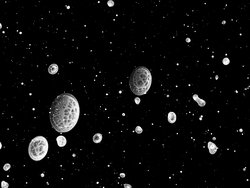
18 OCT | 16H30 | BATALHA CENTRO DE CINEMA - SALA 1 | 77’
Black and White Trypps Number One
2005 | USA | 7’
“A night sky fills with light shimmers and flecks, surface markings, heavenly bodies. It’s an ocean, a well, a screen, a mirror, a portal. Blackness/void cluttered by growing ephemera. Dark reaches of outer and inner space gradually sifts through shards of granite and diamonds. The mind races as the material becomes greater and more frenetic, reaching a nearly audibly grinding pitch of excitement, flurry, and instantaneous infinity that ebbs at first and then maintains. Flashes of color emerge or are imagined. Chaotic flickering of dancing peasant girls and violently twisting astronaut helmets. Layers of sea slime over undulating life forms. Bonfires and celebration. Explosions, construction. Holocausts. Primordial ooze, modern civilization. Ages and seconds. Floating heads circle kaleidoscopic bursts of shiny beads. Everything everywhere twists, forces through, transforms into, overlaps everything else. Seashells, snow, jewels, static, planets, mitochondria, trash, leaves. Rings, flowers, stars, hair, ghosts, comets, cartoons, demons. Icebubblesinstrumentscatsmarblestwigsfirefliespinwheelsinsectscraters. Buzzing. Reeling….. flfkkkkk####################################################
################################################ #Overkill. Birth/ Death. Moment by moment, symmetrical—organized like geometry, like Muslim rugs, like math."
- JT Rogstad, The International Exposition (TIE)
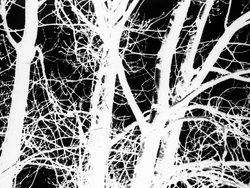
Black and White Trypps Number Two
2006 | USA | 8’
"Ben Russell continues his initial impulse for the series, the exploration of “naturally-derived psychedelia”, with this cadenced phantasmagoria of negative imagery and negative space. The tendrils of sharp white trees become osseous arteries against the black void of the sky. The spiraling spine of a massive tree collides against a spanning pan of a branch twined into two through a mirroring effect. Representation morphs into abstraction as the film becomes a study in density and fearful symmetry in the forest of sight. By film's end, the arboreal is left far behind as the film strip becomes an engulfing, vertiginous maw.”
-Chris Stults, Viennale 2009
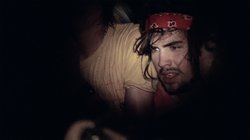
Black and White Trypps Number Three
2007 | USA | 12’
“...a filmic portrait of secular rapture that harks back to the great annunciation canvases of Titian and Caravaggio.”
– Michael Sicinski, Green Cine Daily
“Forget experimental, Trypps Number Three is anthropological filmmaking at its finest – it is a rock and roll Les Maitres Fous.”
– Patrick Friel, Senses of Cinema
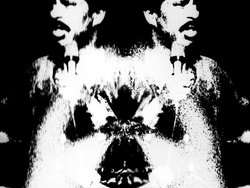
Black and White Trypps Number Four
2008 | USA | 11’
“Jesus Christ, look at the white people, rushing back. White people don’t care, Jack...” - Richard Pryor
Like the previous Trypp, Number Four is a concert film but it is also a return to the “historicized” black and white palate of the first two films. Because the concert footage is from Richard Pryor’s standup act, the Black and White in the title also refers to race. But, almost as a rebuttal to Trypps Number Two, much of the footage here is presented in a Rorschach blot of negative and mirrored imagery so Pryor is portrayed as “white” as often as he is “black.” And through the afterimage resulting from the aggressive flickering, colors emerge leading to, as Russell says, “black and white becoming a fiction – not only in terms of race, but with regard to the material itself.”
- Chris Stults, Viennale Catalogue Essay (2009)

Trypps #5 (Dubai)
2008 | USA | 3 ’
“A radically restricted camera was fixed on half of a neon sign in Ben Russell’s Trypps #5 (Dubai) (2008), which displayed the letters “APP” and only half of a “Y” in an erratic, discontinuous pulse. If the mention of Dubai conjures a cosmopolitan skyline, Russell renounces the possibility of seeing even a single street. As Mark McElhatten writes in the program notes, “Happiness is always, incomplete,” and here, in a critique that Debord may have particularly appreciated, it’s a brightly colored sign for a shop that promises everything but sells nothing.”
– Genevie Yu, Reverse Shot
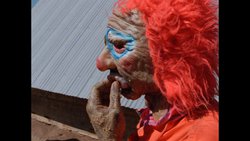
Trypps #6 (Malobi)
2009 | USA | 12’
In Suriname, South America, a man enters a residence and emerges wearing a flamboyant mask with a group of others, each wearing unique masks. A single Steadicam shot follows these unearthly and wizened figures as they slowly hobble through the village, until the procession enters into the center of the village where a celebration is taking place. Suddenly the doddering caravan breaks out into a jungle boogie like persons possessed. We know that this trance dance is all staged for the camera but yet it is also clearly happening. We know we have seen a documentary of some kind ... but a document of what? All that becomes clear is that within documentary, reality becomes image and reality becomes choreography. (Chris Stults)
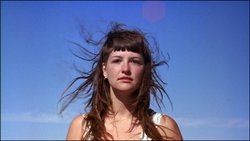
Trypps #7 (Badlands)
2010 | USA | 12’
“Trypps #7 (Badlands) charts, through an intimate long-take, a young woman's LSD trip in the Badlands National Park before descending into a psychedelic, formal abstraction of the expansive desert landscape. Concerned with notions of the romantic sublime, phenomenological experience, and secular spiritualism, the work continues Russell's unique investigation into the possibilities of cinema as a site for transcendence.”
- Michael Green, Museum of Contemporary Art Chicago
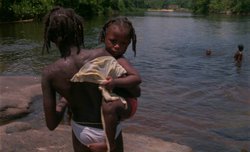
River Rites
2011 | Suriname | 11’30’’
“Animists are people who recognise that the world is full of persons, some of whom are human, and that life is always lived in relationship with others.”
– Graham Harvey, Animism
With this conceptual essay, Ben Russell shares a sensitive experience with us. Plunged into an inversion of time, active witnesses to a fictitious space-time, the illusion is finely crafted. Shot in a single take, he plays on the temporal inversion of the sequence shot, on the image's acceleration and slowing processes, without the trickery of the process being immediately apparent. While the artifice is gradually revealed, our attention is skillfully guided towards the bodies, movements, sounds, music and voices of unidentifiable languages, which intertwine in a hypnotic choreography. (Pascale Paulat, tënk)
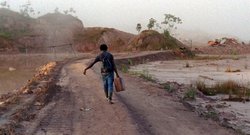
18 OCT | 21H15 | BATALHA CENTRO DE CINEMA - SALA 1 | 143’
Good Luck
2017 | France, Germany | 143’
Filmed between a state-owned large-scale underground mine in the war-torn state of Serbia and an illegal mining collective in the tropical heat of Suriname, Good Luck is a visceral non-fiction portrait of hope and sacrifice in a time of global economic turmoil. “Though much of contemporary thinking would prefer to keep labor and art separated, Good Luck forces them together under an even more unlikely third term, the psychedelic, which has for too long been the domain of reactionaries. With its Latin roots indicating a vision of thought, the psychedelic must be understood as, in at least one sense, analogous with art. Both count their highest achievement as the inducement of reflection. Borrowing from the surrealist tradition, we might take the perfect psychedelic image to be two mirrors gazing directly upon one another. This image is a form of utopia, always awaiting activation by a subject that it desires even as this subject draws it out of the impossible into the actual. Russell’s subject here is labor; to reflect it so fully is a vital achievement.” (Phil Coldiron, CinemaScope)
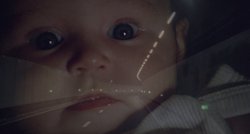
19 OCT | 14H30 | BATALHA CENTRO DE CINEMA - SALA 1 | 60´
AGAIN, TIME
Masterclass em inglês
A masterclass on the various natures of time: as subject, as feeling, as medium, as space. In a moving image practice that spans over two decades, the relative construct that we call time has formed the central inquiry for filmmaker / artist / performer Ben Russell’s work. From the animist jungle time of equatorial Suriname to the horizontal time of an anarchist collective in western France to the haptic experience of Being, temporality is a vehicle by which we can arrive at a transformative understanding of subject, self and audience as a simultaneity that is unique to cinema. Topically speaking, this masterclass can be viewed as a Venn Diagram in which activism, Einstein, ethnography, labor, noise music, and trance cinema are all equally represented.
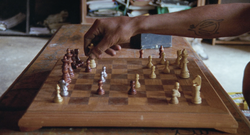
19 OCT | 16H00 | BATALHA CENTRO DE CINEMA - SALA 1 | 213´
Direct Action
2024 | France, Germany | 213’
In January 2018, the construction of an airport in rural Notre-Dame-des-Landes was officially canceled, putting an end to years of resistance led by one of the most important activist communities in France. From 2022-2023, filmmakers Guillaume Cailleau and Ben Russell immersed themselves in the ZAD (zone-to-defend) to create a portrait of collective life in the years after this unprecedented success. The resulting work documents the transformation of a local struggle into a new ecological protest movement - culminating with the Battle of Sainte-Soline in March 2023, where an act of collective direct action against water privatization was again met by the brutality of State violence.
Filmmaking processes are made up of chemical reactions with light that end up generating the image on celluloid. It is precisely from this abyss between what is filmed and what is seen that the great power of DIRECT ACTION by Guillaume Cailleau & Ben Russell manifests itself. Shot on S16mm, the filmmakers document, through an intimate and immersive process, part of the daily life of an important collective of activists who occupied a territory against airport expansion on the outskirts of Paris. The portrayal of the group’s direct actions extends to absolutely every aspect of their lives, from the preparation of bread to a long night on watch. By praising extended time in contrast to ultra-mechanistic life processes, Cailleau & Russell build through blatant simplicity a profound portrait of an activism that reflects on what one thinks and what one does. (Lucas Camargo de Barros, Indielisboa)
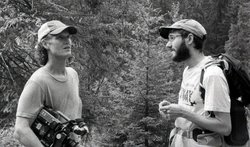
19 OCT | 21H15 | BATALHA CENTRO DE CINEMA - SALA 1 | 83’
Closing session and awards ceremony
THE INVISIBLE MOUNTAIN
2021 | USA | 83’
A hallucinatory portrait of a man traveling from Finland to Greece in search of the utopian summit described in René Daumal’s 1952 novel Mount Analogue, a fictional mountain floating in the sea. Equal parts nonfiction cinema, concert film, road movie, and spiritual quest, The Invisible Mountain is accompanied by immersive musical performances from Finnish guitar trio Olimpia Splendid and American percussionist Greg Fox.
“Ben Russell continues his path and his rise to the summit with his latest work inspired by René Daumal’s Mont Analogue, a remarkable text that seems to have been written especially for him. From this literary source, we understand what is read to us: a spiritual and collective quest involving the search for a mountain that’s out of sight. Russell transposes this to his own filmmaking – condensing all the meditative power into the image. La Montagne Invisible is a long Trypps (the name of the short, experimental forms produced by B.R.) reconnecting with the mysteries of transcendence and psychedelic pleasures. Russell creates a structure that weaves between a portrait gallery (of touring musicians) and the solitary roaming of a man who sets off to hunt down the fleeting apparitions of the invisible mountain. The lanky figure is filmed from behind in a dolly shot following in the wake of his strides. The opening chords of Nirvana's Come As You Are leads into a song by Finnish witch-trio Olimpia Splended, riddled with scratchy guitars and layers of sound that make the faces and landscapes elastic. Russell warps space and time, using sliding and circular movements around the faces he films. Although as he progresses, the character crosses varied landscapes, we experience an immobile journey. The “elsewhere” is primarily in the filmmaking, which the director inhabits by moving to the other side of the camera (with the complicity of Ben Rivers), forming an unexpected tandem with his character – a fusion of the imaginary territory of the spiritual quest and the making of the movie. The vastest wilderness and the highest peaks are those within. Finding them requires that we recognise the passages and doors. Music is one of those doors, and Russell’s hallucinatory visions offer us a dazzling cinematographic translation of its perceptible possibilities. Ben Russell’s “mont analogue” is music made into an image, the analogue film of music.”
(Claire Lasolle, FIDMarseille 2021)